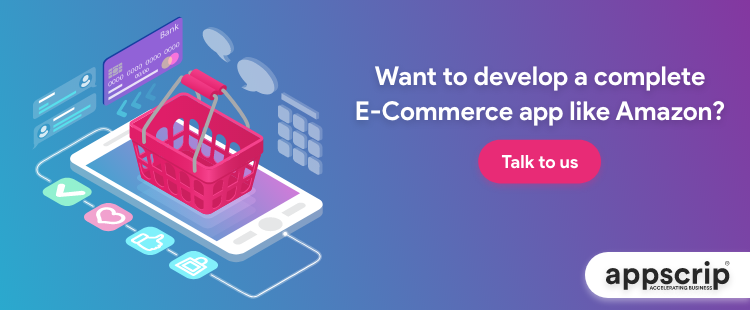Cost of developing an app like Amazon involves several cost factors such as:
- Development team: The size and expertise of the development team required for designing, coding, testing, and deploying the app.
- Features and complexity: The number and complexity of features integrated into the app will influence the cost.
- Design and user experience: UX and UI designs are crucial elements in app development. Creating a visually appealing and user-friendly interface can increase the cost.
- Backend infrastructure: Developing a scalable and efficient backend infrastructure that can handle a large user base and high traffic will add to the cost.
- Third-party integrations: The integration of payment gateways, logistics providers, analytics tools, or other external services can incur additional expenses.
- Maintenance and updates: Ongoing maintenance, bug fixes, and updates to ensure the app remains secure, functional, and compatible with new devices and OSs will contribute to the overall cost.
- Security and compliance requirements: Implementing robust security measures and ensuring compliance with data protection regulations may increase development costs.
- Development Timeline: The development timeline can affect the cost.
Timeline To Develop An App Like Amazon
| App Type | Estimated cost | Timeline |
| Simple app with basic features | $40 – 60 K | 3 – 6 Months |
| Not too complex app with extensive features | $60 – 100 K | 6 – 9 Months |
| Highly complex app with complex features | $100 – 300 K | 9 – 12 Months |
App Platform and Technology Stack Selection
The choice of app platform (iOS, Android, both) and tech stack (a combination of PLs, frameworks, libraries, and tools) are critical decisions in app development.
The selection depends on factors such as the app’s functionality, budget, development team’s expertise, target audience, development timeline, scalability needs, and the ability to integrate with other systems or APIs.
Native v/s Cross-platform App Development
Native app development involves building separate apps for each platform using platform-specific programming languages (Swift or Objective-C for iOS, Java or Kotlin for Android).
This approach offers the best performance, access to device-specific features, and a native user experience.
Cross-platform app development involves using frameworks like React Native, Flutter, or Xamarin to build a single codebase that can run on multiple platforms.
This allows developers to write code once and deploy it on both iOS and Android, saving time and effort. However, cross-platform apps may have performance limitations and suffer access to platform-specific features.
The choice between native and cross-platform development depends on factors such as budget, development resources, app complexity, target audience, desired performance, and time-to-market requirements.
App Design and User Interface
App design and user interface (UI) are important to attract and retain users. Ideally the design should be consistent, responsive across devices, and optimised for usability.
- Importance of user-centric design
Prioritising user-centric design can lead to higher user satisfaction, increased usage, and ultimately, better business outcomes.
- Custom UI/UX development
Custom UI/UX development involves creating unique and tailored design elements and user experiences specific to the app’s branding and target audience.
- Integration of branding elements
Integrating branding elements, such as logos, colour schemes, and typography, into the app design helps reinforce brand identity and create a consistent user experience.
Functionalities and Features
The functionalities and features of an app like Amazon are extensive like product listing and details, personalised recommendations, social sharing, order history, wish-list creation, customer support, and more.
- Catalogue management
- Search and filtering options
- Shopping cart and checkout process
- User authentication and profiles
- Order tracking and notifications
- Payment gateway integration
- Customer reviews and ratings
Backend Development
Backend development involves building the server-side logic, database management, and API development. The cost of backend development depends on the complexity of the app and the tech stack used.
- Server infrastructure selection (cloud hosting, on-premises)
Cloud hosting or on-premises infrastructure depends on factors like scalability, maintenance, and cost.
Cloud hosting, offers scalability, flexibility, and reduced infrastructure management.
On-premises infrastructure requires higher upfront costs for hardware, maintenance, and scalability limitations.
- Database management
To handle the app’s data, the options are relational databases (MySQL, PostgreSQL) or NoSQL databases (MongoDB, Cassandra).
The choice hinges on data structure, scalability needs, and cost.
- API development for seamless integration
API development allows seamless integration with external services, such as payment gateways, shipping providers, or third-party services. The cost depends on the complexity and number of integrations required.
- Scalability and performance considerations
Ensuring scalability and performance requires designing the app to handle increased user load. This may involve load balancing, caching mechanisms, and server optimisation techniques.
Third-Party Integrations
Third-party integrations with social media platforms, payment gateways, shipping providers, and other services enhance the app’s functionality. The cost depends on the number of integrations and complexity of the APIs.
- Social media login and sharing
Implementing social media login and sharing features involves integrating with platforms like FB, Twitter, or Google.
- Shipping and logistics integration
Integrating with shipping and logistics providers, such as UPS, FedEx, or DHL, enables efficient order processing and tracking.
- Analytics and reporting tools
Implementing analytics and reporting tools helps track user behaviour, sales, and other metrics.
- CRM and customer support systems
Implementing CRM and customer support systems enables effective management of customer interactions and support requests.
Security and Data Protection
Security measures ensure the protection of user data and the app’s infrastructure. Implementing SSL/TLS encryption for secure communication, secure payment gateways, and compliance with data protection regulations are essential.
- SSL/TLS encryption
Implementing SSL/TLS encryption involves obtaining and configuring SSL certificates and ensuring that all data exchanged between the app and its servers is encrypted.
- Secure payment gateways
Integrating secure payment gateways, such as those compliant with Payment Card Industry Data Security Standard (PCI DSS), requires additional development effort and involves additional costs.
- Compliance with data protection regulations
Complying with data protection regulations, such GDPR or CCPA, involves implementing appropriate privacy measures, securing user data, obtaining user consent, and providing transparency in data handling practices.
- User data privacy measures
Implementing features like data anonymisation, consent management, and privacy policy adherence may require additional development efforts.
Testing and Quality Assurance
Testing and quality assurance are essential steps in the development of any app. This process involves both manual and automated testing.
- Manual and automated testing
- Bug fixing and performance optimisation
- Ensuring app compatibility across devices
App Maintenance and Updates
App maintenance involves regular bug fixes, security patches, and updates to keep the app functioning smoothly and securely. This includes addressing user feedback, incorporating feature enhancements, and ensuring compatibility with new devices or operating system versions.
- Regular bug fixes and security patches
- Feature enhancements and updates
- Customer support and feedback incorporation

Cost of Developing an App Like Amazon
The cost of developing an app like Amazon can vary significantly based on several factors like complexity of the app, the number of features, the size of the development team, the development approach (in-house or outsourcing), and the hourly rates of developers.
- Hiring a Development Team
- In-house development vs. outsourcing
- Factors affecting development costs
- Hourly rates of developers
Development Timeline
The development timeline includes various stages, such as gathering requirements, design, development, testing, deployment, and post-launch support.
More complex features, integrations, and customisations require additional time for development, testing, and debugging.
Additional costs include app hosting and server expenses, such as cloud infrastructure, data storage, and bandwidth requirements. Additionally, third-party service subscriptions also incur costs.
Conclusion
Those looking to enter the thriving e-commerce market, have a perfect tool to help you establish and grow your online business. Our innovative product provides a comprehensive platform that enables you to create your own feature-rich, scalable, and customisable multi-vendor marketplace.
The product has amazing features such as easy setup and customisation, scalability and flexibility, vendor management, secure payment processing, analytics, and reporting and more.
Our product can establish your brand, attract a wide range of vendors, and provide a seamless shopping experience to your customers. With its comprehensive set of features and robust infrastructure, this solution offers a solid foundation for success in the dynamic world of e-commerce.

After an Engineering degree and a Diploma in Management I devoted 16+ years working in the automotive industry. My innate skill and extreme passion in writing, encouraged me to adopt it up as a profession. I have been writing for more than 10+ years in the software industry. The 400+ blogs I published are informative, exhaustive and interesting to a professional and causal reader.









